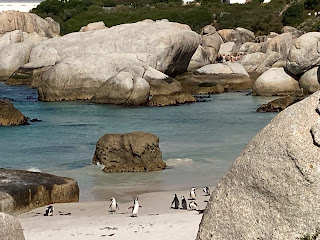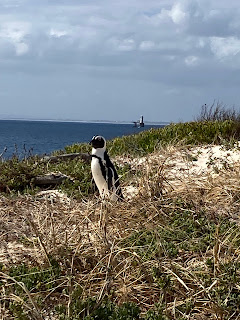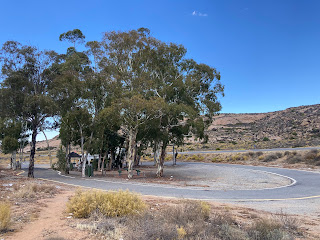April Break - South Africa
We arrived in Cape Town, South Africa, at night, March 31st. It's kind of fun to walk out of the airport and find someone holding a sign with your name on it. It's also expensive!
Cape Town is a beautiful city and one day is no where near enough time to explore it. Our one day was also a public holiday so we saw lots of families and quite a few places that were closed.
Cape Town doesn't feel like the other major African cities we have visited. The infrastructure of apartheid persists with whites living in the cities and blacks living in the former townships surrounding the cities. The economic divide is very real.
This is Lion's Head mountain and the small, colored splotches are paragliders.To the left of Lion's Head is Signal Hill, also known as Lion's Rump. When you're farther away, together they actually look like a lion lying down.
There's a huge stadium from the 2010 World Cup that sat unused for several years until it was repurposed for rugby. Now there's a professional rugby team, the Stormers, that uses it.
We couldn't go inside but it seats 55,000 people.On the right is Table Mountain - for obvious reasons.The gorgeous Atlantic coast with no shortage of souvenirs for sale!
Just like the old Silver Creek Cliff road or Red Mountain Pass!
At this point, we continued east to the False Bay side of the peninsula to see...African Penguins!!A colony of African penguins lives in a protected sanctuary called Boulders Beach.The commercial fishing in False Bay is very limited which makes the waters attractive for penguins.
These guys are sooooo loud! They make a braying noise and were originally called jackass penguins because of it.
Now the parent is bent over feeding or cleaning the chick.
This cutie is sitting on an egg. African penguins are monogamous and both parents will care for the egg(s) and chick(s). There can lay one or usually two at a time. For the first month, the parents take turns caring for the chicks and never leave the chicks alone. After a month, chicks from different parents will be left in a group called a creche. This is for protection from predators. We didn't see any creches.African penguins have adapted to a region with warmer temperatures than in Antarctica where penguins live on ice. The waters of False Bay are cold and rich with food. The penguins hold their flippers away from their bodies to dissipate heat. Special glands above their eyes also aid in cooling off. And they don't wear leggings, that is, there are no feathers on their legs which also helps keep them cooler. Artificial burrows at the sanctuary are in the shade and partially buried to help with the heat. We visited in the fall and the temperature was pleasant for us non-penguins.
At the sanctuary, visitors walk on a boardwalk to view the penguins. It is a great way to watch without disturbing them.
From the penguin sanctuary, we continued south to the Cape of Good Hope. Look closely at the sign as they qualify this by adding the most "south-western" point. The true point that is furthest south on the continent is Cape Agulhas, about 30 miles east. This sign is all for the tourists because this point is closer to Cape Town than Cap Agulhas.
All the tourists waiting to have their picture taken at the Cape of Good Hope sign.I would have loved to walk up to this knoll but our tour leader didn't give us enough time.So, I waded in the water amongst the rocks and bull kelp.A little further east along the road is Cape Point where there is an old lighthouse.
The buildings below house the upper landing for the funicular.The next day, April 2nd, we met our Nomad tour group and loaded up. We started the tour with 12 people and two Zimbabwean guides. Our first stop was a flower and craft market in Cape Town.
Beautiful beadwork!
Everything a tourist could ever want.The drive took us north of Cape Town through an extensive farming region. Every possible piece of terrain was cultivated, field after field after field for 100-150 km until Citrusdal where we crossed a pass and the landscape changed.
More fieldsCitrusdal is the original, authentic Rooibos tea growing area. Just as Champagne has specific rules about what can be called Champagne, the same is true for Rooibos tea. If the tea does not come from this region, even if it's grown from the same tea plant, it can't be called Rooibos. These are called rules of appellation (a French word since it started with Champagne.)Rooibos or red bush tea plantsTasting different Rooibos teas - you can mix other types of tea with itA place to customize your Rooibos tea, mix what you want and brew your own tea at home.This shop had so much tea for sale, they even had their own children's teas.My first pomegranate tree. It looks like a deciduous tree with red Christmas balls.
As we continued driving north toward Namibia, the landscape became more and more arid. We saw agricultural fields, but only near rivers where irrigation was easier.
This is most likely a community of farm workers.
When we past through towns, we would stop at supermarkets or shopping malls and use the bathrooms. When there were no towns, the truck would pull over to the side of the road for "bushy bushy." Although in some places, the bushes were either hard to find or very small.More desert images as we neared the Namibian border
Time for a bushy bushy stop!When we past through towns, we would stop at supermarkets or shopping malls and use the bathrooms. When there were no towns, the truck would pull over to the side of the road for "bushy bushy." Although in some places, the bushes were either hard to find or very small.More desert images as we neared the Namibian border
The road was paved and in good condition. We didn't see much other traffic.This is the South African version of a rest area, at least in this part of the country. There were concrete picnic tables and benches but no bathroom facilities. Generally, people left a lot of trash behind.
We occupied only 12 of the 24 seats in the truck, plus the two guides in the front. Someone put a lot of thought into designing these trucks so efficiently. There were compartments for all the food, pots, pans, gas cooking stove, dishware, freezer, water and a water filter along with tables, chairs, tents, sleeping pads, and lockers for our bags (we were told not to bring roller bag suitcases but some people did). Mama Twembwe was our Zimbabwean cook and we never had a bad meal. In fact, it was hard not to eat too much. She cooked a mix of African and western foods and always more than we could eat. The leftovers she wrapped in foil and gave to people who worked in the places we stayed.
We occupied only 12 of the 24 seats in the truck, plus the two guides in the front. Someone put a lot of thought into designing these trucks so efficiently. There were compartments for all the food, pots, pans, gas cooking stove, dishware, freezer, water and a water filter along with tables, chairs, tents, sleeping pads, and lockers for our bags (we were told not to bring roller bag suitcases but some people did). Mama Twembwe was our Zimbabwean cook and we never had a bad meal. In fact, it was hard not to eat too much. She cooked a mix of African and western foods and always more than we could eat. The leftovers she wrapped in foil and gave to people who worked in the places we stayed.
Our trip was off to a great start!
































































Penguins, pomegranate trees, and "bushy-bushy" stops (what even are those??). More fun times for you both!
ReplyDelete